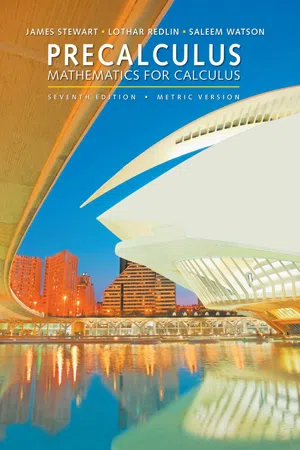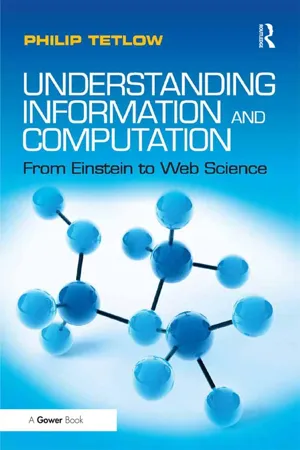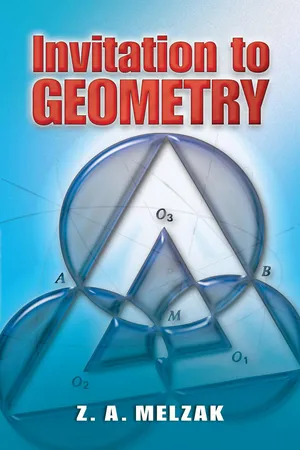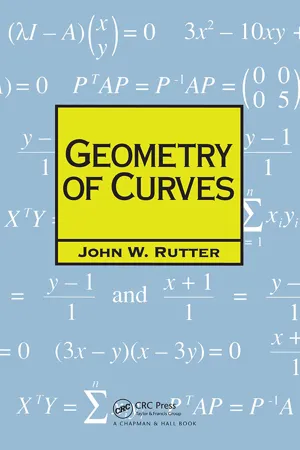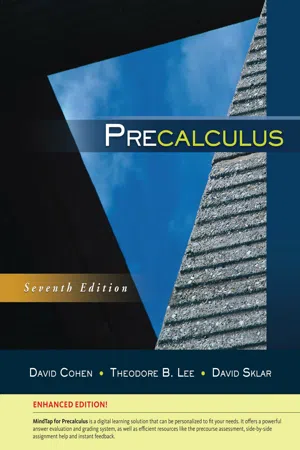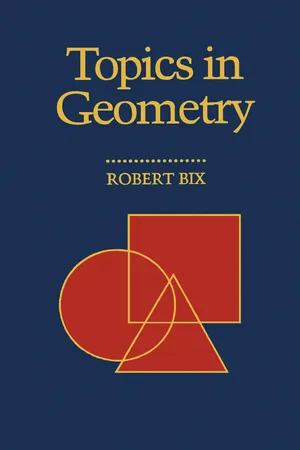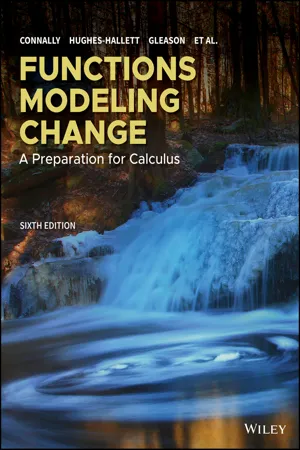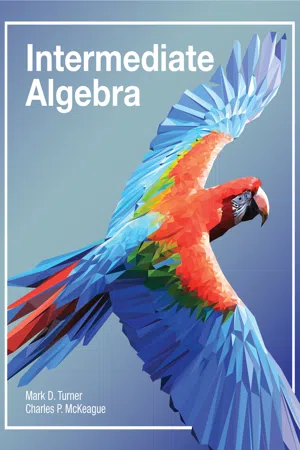Mathematics
Conic Sections
Conic sections are the curves formed by the intersection of a plane with a cone. The four main types of conic sections are the circle, ellipse, parabola, and hyperbola. They are fundamental in geometry and have applications in various fields such as physics, engineering, and astronomy. Each type of conic section has distinct properties and equations that describe its shape.
Written by Perlego with AI-assistance
Related key terms
1 of 5
12 Key excerpts on "Conic Sections"
- eBook - PDF
- James Stewart, Lothar Redlin, Saleem Watson, , James Stewart, Lothar Redlin, Saleem Watson(Authors)
- 2015(Publication Date)
- Cengage Learning EMEA(Publisher)
Conic Sections are the curves that are formed when a plane cuts a cone, as shown in the figure. For example, if a cone is cut horizontally, the cross section is a circle. So a circle is a conic section. Other ways of cutting a cone produce ellipses, parabolas, and hyperbolas. Ellipse Parabola Hyperbola Circle Our goal in this chapter is to find equations whose graphs are Conic Sections. We will find such equations by analyzing the geometric properties of Conic Sections. These properties make Conic Sections useful for many real-world applications. For instance, a reflecting surface with parabolic cross sections concentrates light at a single point. This property of a parabola is used in the construction of solar power plants, like the one in California pictured above. In the Focus on Modeling at the end of the chapter we explore how these curves are used in architecture. 547 Conic Sections 7 7.1 Parabolas 7.2 Ellipses 7.3 Hyperbolas 7.4 Shifted Conics FOCUS ON MODELING Conics in Architecture Harald Sund/The Image Bank/Getty Images Copyright 2016 Cengage Learning. All Rights Reserved. May not be copied, scanned, or duplicated, in whole or in part. Due to electronic rights, some third party content may be suppressed from the eBook and/or eChapter(s). Editorial review has deemed that any suppressed content does not materially affect the overall learning experience. Cengage Learning reserves the right to remove additional content at any time if subsequent rights restrictions require it. 548 CHAPTER 7 ■ Conic Sections 7.1 PARABOLAS ■ Geometric Definition of a Parabola ■ Equations and Graphs of Parabolas ■ Applications ■ Geometric Definition of a Parabola We saw in Section 3.1 that the graph of the equation y ax 2 bx c is a U-shaped curve called a parabola that opens either upward or downward, depend-ing on whether the number a is positive or negative. In this section we study parabolas from a geometric, rather than an algebraic, point of view. - No longer available |Learn more
- James Stewart, Lothar Redlin, Saleem Watson(Authors)
- 2016(Publication Date)
- Cengage Learning EMEA(Publisher)
Conic Sections are the curves that are formed when a plane cuts a cone, as shown in the figure. For example, if a cone is cut horizontally, the cross section is a circle. So a circle is a conic section. Other ways of cutting a cone produce ellipses, parabolas, and hyperbolas. Ellipse Parabola Hyperbola Circle Our goal in this chapter is to find equations whose graphs are Conic Sections. We will find such equations by analyzing the geometric properties of Conic Sections. These properties make Conic Sections useful for many real-world applications. For instance, a reflecting surface with parabolic cross sections concentrates light at a single point. This property of a parabola is used in the construction of solar power plants, like the one in California pictured above. In the Focus on Modeling at the end of the chapter we explore how these curves are used in architecture. 781 Conic Sections 11 11.1 Parabolas 11.2 Ellipses 11.3 Hyperbolas 11.4 Shifted Conics 11.5 Rotation of Axes 11.6 Polar Equations of Conics FOCUS ON MODELING Conics in Architecture Harald Sund/The Image Bank/Getty Images Copyright 2017 Cengage Learning. All Rights Reserved. May not be copied, scanned, or duplicated, in whole or in part. Due to electronic rights, some third party content may be suppressed from the eBook and/or eChapter(s). Editorial review has deemed that any suppressed content does not materially affect the overall learning experience. Cengage Learning reserves the right to remove additional content at any time if subsequent rights restrictions require it. 782 CHAPTER 11 ■ Conic Sections 11.1 PARABOLAS ■ Geometric Definition of a Parabola ■ Equations and Graphs of Parabolas ■ Applications ■ Geometric Definition of a Parabola We saw in Section 3.1 that the graph of the equation y ax 2 bx c is a U-shaped curve called a parabola that opens either upward or downward, depend- ing on whether the number a is positive or negative. - eBook - ePub
Understanding Information and Computation
From Einstein to Web Science
- Philip Tetlow(Author)
- 2016(Publication Date)
- Routledge(Publisher)
9Why Are Conic Sections Important?Poetry is as precise a thing as geometry .Gustave FlaubertIn mathematics, a conic section, or just ‘conic’, is a curve obtained by intersecting a cone, or more precisely, a circular conical surface, with a plane. A conic section is therefore a restriction of a quadric1 surface to the plane. Conic Sections, in all their various forms, were named and studied as long ago as 200 BC, when Apollonius of Perga undertook a systematic study of their properties.[39]In all, there are three types of conics named the ellipse, the hyperbola and parabola. The circle can be considered as a fourth type, as it was by Apollonius of Tyana2 , or as a kind of ellipse, thereby making it inclusive to the three original forms. The circle and the ellipse arise when the intersection of cone and plane is a closed curve. The circle is obtained when the cutting plane is parallel to the plane of the generating circle of the cone. If the cutting plane is parallel to exactly one generating line of the cone, then the conic is unbounded and is called a parabola. In the remaining case, the conic formed is hyperbolic. In this case the plane will intersect both halves, or nappes, of the cone, producing two separate unbounded curves, though often one is ignored.[39]The conic section is a key concept in abstract mathematics, but it is also seen with considerable regularity in the material world, with many practical applications in engineering, physics, and other fields. Furthermore the conic section may well hold the key to addressing an apparent weakness in the ‘X ’-shaped pattern. Before that can be considered, however, we must first understand that there are two types of possible behaviour in computational systems, those being linear and non-linear.Figures 9.1(a), 9.1(b) and 9.1(c) The various types of conic sectionLinear Systems
Look up linearity in the dictionary and the following definition will be found: linear –adjective 1. of, consisting of, or using lines: linear design - eBook - ePub
- Z. A. Melzak(Author)
- 2014(Publication Date)
- Dover Publications(Publisher)
CHAPTER FIVEConic Sections AND PASCAL’S THEOREM
The simplest curves of geometry are straight lines and circles. Then come ellipses, parabolas, and hyperbolas, collectively known as Conic Sections. These are usually studied by the method of analytic geometry: The ordinary rectangular coordinate system is introduced in the plane, a conic section is defined as the locus of all points with a certain property, and then an equation between x and y is developed that holds if and only if the point (x , y ) has that property. In terms of the focal properties the definitions are as follows:Ellipse: locus of all points in the plane for which the sum of distances from two fixed points (the foci) is constant Hyperbola: locus of all points in the plane for which the difference of distances from two fixed points (the foci) is constant Parabola: locus of all points in the plane equidistant from a fixed point (the focus) and a fixed line (the directrix). The analytic method was introduced in the seventeenth century by the French philosopher and mathematician René Descartes. It is so powerful and far-reaching that it has largely overwhelmed the earlier synthetic method, which proceeds by purely geometrical constructions and without coordinates or algebra. However, the synthetic method was used in antiquity by the Greek geometers who discovered Conic Sections and developed a fairly complete theory. Their interest stemmed partly from attempts to solve the three classical problems of ancient geometry: to square the circle, to trisect any angle, to double the cube.The last task is known as the Delian problem because, according to a story, a priest of Apollo’s shrine in Delos dreamt once that the god Apollo ordered his cubical altar to be doubled. According to the shrewd Greek interpretation this amounted to constructing the side of a cube whose volume is twice that of a given cube. In simpler terms, what one wants is a geometrical construction of the number In the process of such a construction only the standard use of ruler and compasses is allowed. While is easily obtained as the diagonal of the unit square, it turns out that - eBook - PDF
- David A. Brannan, Matthew F. Esplen, Jeremy J. Gray(Authors)
- 2011(Publication Date)
- Cambridge University Press(Publisher)
1 Conics The study of conics is well over 2000 years old, and has given rise to some of the most beautiful and striking results in the whole of geometry. In Section 1.1 we outline the Greek idea of a conic section – that is, a conic as defined by the curve in which a double cone is intersected by a plane. We then look at some properties of circles, the simplest of the non-degenerate conics, such as the condition for two circles to be orthogonal and the equations That is, they intersect at right angles. of the family of all circles through two given points. We explain the focus–directrix definition of the parabola, ellipse and hyper-bola, and study the focal-distance properties of the ellipse and hyperbola. Finally, we use the so-called Dandelin spheres to show that the Greek Conic Sections are just the same as the conics defined in terms of a focus and a directrix. In Section 1.2 we look at tangents to conics, and the reflection properties of the parabola, ellipse and hyperbola. It turns out that these are useful in prac-tical situations as diverse as anti-aircraft searchlights and astronomical optical telescopes! We also see how we can construct each non-degenerate conic as the ‘envelope’ of lines in a suitably-chosen family of lines. The equations of conics are all second degree equations in x and y . In Section 1.3 we show that the converse result holds – that is, that every sec-ond degree equation in x and y represents a conic. We also find an algorithm for determining from its equation in x and y which type of non-degenerate conic a given second degree equation represents, and for finding its principal features. The analogue in R 3 of a plane conic in R 2 is a quadric surface , specified We use the notation R 2 and R 3 to denote 2-dimensional and 3-dimensional Euclidean space, respectively. by a suitable second degree equation in x , y and z . A well-known example of a quadric surface is the cooling tower of an electricity generating station. - eBook - PDF
- J.W. Rutter(Author)
- 2018(Publication Date)
- Chapman and Hall/CRC(Publisher)
1.3 Conies Conies, or Conic Sections, are curves which are the intersection of a complete cone in R 3 with a plane. In Figure 1.4 the axis of the cone lies in the plane of the page. The cone meets this plane in the two solid lines. The dotted lines indicate the intersection of this plane with three planes perpendicular to it. These three planes intersect the cone in an ellipse, a hyperbola, and a parabola as indicated. Other cases which can occur as a geometrical intersection of a plane and a cone are a pair of distinct intersecting lines, a single (iterated) line, or a single point; in each of these cases the plane passes through the 'point' of the cone. The general quadratic equation is ax 2 + 2hxy + by 2 4-2cx + 2dy + k = 0. This is sometimes called the 'general equation of a conic', though not all such equations determine a geometrical conic. Ellipses, hyperbolae, parabo-lae, and pairs of distinct intersecting or parallel lines are all determined by such an equation as are certain degenerate cases. We can use a rotation of the plane which diagonalises the quadratic form ax 2 -f 2hxy -f by 2 to a quadratic form XX 2 -f pY 2 , then we can use a suitable translation (change of origin) to obtain the equation in one of the canonical forms; the proof that this can be done and the procedure for doing it are given in §2.1. We first consider the canonical forms for the ellipse, the hyperbola, and 16 Lines, circles, and conies Elliptic section Parabolic section Figure 1.4 Sections of a complete cone. the parabola. The word canonical here relates to the position of the co-ordinate axes for the given curve; in the case of the ellipse (other than a circle) and hyperbola these are the two (unique) axes of symmetry. 1.4 The ellipse in canonical position In many situations the circle (see §2.1) can be regarded as a special case of an ellipse. However we consider in this section only ellipses which are not circles, that is we assume that a > b (see below). - eBook - PDF
- David Cohen, Theodore Lee, David Sklar, , David Cohen, Theodore Lee, David Sklar(Authors)
- 2016(Publication Date)
- Cengage Learning EMEA(Publisher)
However, until the seventeenth century the Conic Sections were studied only as a portion of pure (as opposed to applied) mathematics. Then, in the seventeenth century, it was discovered that the Conic Sections were crucial in expressing some of the most important laws of nature. This is essentially the observation made in the opening quotation by the physicist J. L. Synge. In this chapter you’ll see examples where conics are used in: • The design of a radio telescope (Example 6 in Section 12.2) • The design of an arch (Exercise 41 in Section 12.2) • Analyzing the orbit of a comet or planet (Example 7 in Section 12.4) • Determining a location on earth without recourse to a global positioning system (online Project for Section 12.5) CHAPTER 12 The Conic Sections 12.1 THE BASIC EQUATIONS As background for the work in this chapter, you need to be familiar with the follow-ing results from Chapter 1. 1. The distance formula: 2. The equation for a circle: ( x h ) 2 ( y k ) 2 r 2 d 2 ( x 2 x 1 ) 2 ( y 2 y 1 ) 2 Circle Ellipse Parabola Hyperbola Circle Line L Image Copyright Jonathan Larsen, 2010. Used under license from Shutterstock.com Copyright 201 Cengage Learning. All Rights Reserved. May not be copied, scanned, or duplicated, in whole or in part. Due to electronic rights, some third party content may be suppressed from the eBook and/or eChapter(s). Editorial review has deemed that any suppressed content does not materially affect the overall learning experience. Cengage Learning reserves the right to remove additional content at any time if subsequent rights restrictions require it. 3. The slope of a line: 4. The point–slope formula: y y 1 m ( x x 1 ) 5. The slope–intercept formula: y mx b 6. The condition for two nonvertical lines to be parallel: m 1 m 2 7. The condition for two nonvertical lines to be perpendicular: m 1 m 2 1 8. The midpoint formula: In this section we are going to develop two additional results to supplement those we just listed. - eBook - PDF
- Bernard Kolman, Arnold Shapiro(Authors)
- 2014(Publication Date)
- Academic Press(Publisher)
In general, place the given geometric figure in a convenient position relative to the origin and axes. The distance formula, the midpoint formula, and the computation of slope are the tools to apply in proving a theorem. The Conic Sections represent the possible intersections of a plane and a cone. The Conic Sections are the circle, parabola, ellipse, and hyperbola. (In special cases these may reduce to a point, a line, or two lines.) Each conic section has a geometric definition which can be used to derive a second-degree equation in two variables whose graph corresponds to the conic. A second-degree equation in JC and y can be converted from general form to standard form by completing the square in each variable. It is much simpler to sketch the graph of an equation when it is written in standard form. It is often possible to distinguish the various Conic Sections even when the equation is given in general form. PROGRESS TEST 8A 339 REVIEW EXERCISES In Exercises 1-3 find the midpoint of the line segment whose endpoints are given. 1. (-5,4) (3,-6) 2. (-2,0), (-3,5) 3. (2,-7), (-3,-2) 4. Find the coordinates of the point P 2 if (2,2) are the coordinates of the midpoint of the line segment joining P t (-6,-3) and P 2 . 5. Use the distance formula to show that P^-1,2), P 2 (4,3), P 3 (l,-1), and P 4 (-4,-2) are the coordinates of a parallelogram. 6. Show that the points A(-8,4), 5(5,3), and C(2,-2) are the vertices of a right triangle. 7. Find an equation of the perpendicular bisector of the line segment joining the points A(-4,-3) and 5(1,3). (The perpendicular bisector passes through the midpoint of AB and is perpendicular to AB.) 8. Write an equation of the circle whose center is (-5,2) and that has a radius of 4. 9. Write an equation of the circle whose center is (-3,-3) and that has a radius of 2. In Exercises 10-15 determine the center and radius of the circle with the given equation. 10. (x -2) 2 + (y + 3) 2 = 9 11. (x + yY + (y -4) 2 =^ 12. - eBook - PDF
- Robert Bix(Author)
- 2014(Publication Date)
- Academic Press(Publisher)
In the seventeenth century also, Rene Descartes and Pierre de Fermat developed analytic geometry. John Wallis characterized the Conic Sections as the graphs of nondegenerate quadratic equations in two variables, and he deduced properties of the Conic Sections from these equations. In Section 21, we review the familiar classification of the graphs of these equations as Euclidean ellipses, Euclidean parabolas, and Euclidean hyperbolas. In the exercises of Section 21, we use coordinates to derive the reflection proper-ties and other focal properties of Conic Sections. At the end of the seventeenth century, Isaac Newton used the inverse-square law of gravitational attraction to deduce the laws of planetary motion that Johannes Kepler had asserted at the start of the century. In particular, Newton proved that bodies move along Conic Sections exactly when they are subject to an inverse-square law force. Newton also proved a number of results in which a conic section is uniquely determined by five given conditions. One result of this type is Theorem 22.8, which shows that a conic section is uniquely determinbed by five of its points. Exercises 22.3 and 22.4 contain analogous results. Section 19. Cross-Ratios 369 Projective geometry was revived in the nineteenth century by mathe-maticians reacting against the algebraic and analytic computations that dominated geometry in the eighteenth century. They sought to base projective geometry on general principles such as duality and to develop it independently of Euclidean geometry. Jacob Steiner and Michel Chasles gave intrinsic characterizations of Conic Sections in the projective plane, including some of the characterizations in Section 22. Karl Georg Christian von Staudt found an intrinsic construction of coordinates on a line in the projective plane. - eBook - ePub
- Mary Jane Sterling(Author)
- 2019(Publication Date)
- For Dummies(Publisher)
Chapter 12Conquering Conic Sections
IN THIS CHAPTERClosing in on circlesGraphing parabolas, ellipses, and hyperbolasRecognizing the different Conic SectionsWorking with parametric form and polar coordinatesWho doesn’t love a good cone? Some are big fans of a double-dip ice cream cone, but maybe you’re partial to the traffic cone because it keeps you safe on the road. Whatever type of cone is your favorite, for mathematicians the cone is the creative fuel for the fire of a whole bunch of ideas.You see, about 2,200 years ago, some smart mathematician named Apollonius of Perga decided to stack two cones point to point. He sliced them in different directions and came up with four different Conic Sections: the circle, the ellipse, the parabola, and the hyperbola. Each conic section has its own equation and its own parts, which you need to determine in order to graph it. You may wish to graph a conic section, identify certain parts, or write its equation. The basis of any of these tasks is to be able to recognize what kind of conic section it is and write it in its own equation form.When a conic section is already written in its standard form, you know most of the information about the parts of that particular conic. When a conic section isn’t written in its standard form, you first have to write it that way. How do you do that? You find that information in this chapter.A Quick Conic Review
A basic process used to change a conic section’s equation into the standard form is completing the square - eBook - PDF
Functions Modeling Change
A Preparation for Calculus
- Eric Connally, Deborah Hughes-Hallett, Andrew M. Gleason(Authors)
- 2019(Publication Date)
- Wiley(Publisher)
Conic Sections are so called because, as was demonstrated by the Greeks, they can be constructed by slicing, or sectioning, a cone. Conic Sections arise naturally in physics, since the path of a body orbiting the sun is a conic section. We will study them in terms of parametric and implicit equations. As we have already studied parabolas, we now focus on circles, ellipses and hyperbolas. Circles Example 2 Graph the parametric equations = 5 + 2 cos and = 3 + 2 sin . Solution We see that varies between 3 and 7 with a midline of 5 while varies between 1 and 5 with a midline of 3. Figure 14.18 gives a graph of this function. It appears to be a circle of radius 2 centered at the point (5, 3). 1 2 3 4 5 6 7 1 2 3 4 5 (5, 3) Figure 14.18: The circle defined by = 5 + 2 cos , = 3 + 2 sin , 0 ≤ ≤ 2 (ℎ, ) = (, ) ✲ ✛ = ℎ + cos ✲ ✛ ℎ ✲ ✛ cos ✻ ❄ ✻ ❄ sin ✻ ❄ = + sin Figure 14.19: A circle of radius centered at the point (ℎ, ) Compare Figure 14.18 with Figure 14.19, which shows a circle of radius centered at the point (ℎ, ). The coordinates of a point = (, ), corresponding to an angle , are given by = ℎ + cos and = + sin . The equations in Example 2 are of this form, with instead of and with ℎ = 5, = 3, and = 2. This curve is a circle because the point is always a fixed distance, 2, from the point (5, 3). 14.2 IMPLICITLY DEFINED CURVES AND CIRCLES 14-13 For > 0, the parametric equations of a circle of radius centered at the point (ℎ, ) are: = ℎ + cos = + sin 0 ≤ ≤ 2. Eliminating the Parameter in the Equations for a Circle To eliminate the parameter from the parametric equations for a circle, we rewrite the equations as − ℎ = cos so ( − ℎ) 2 = 2 cos 2 and − = sin so ( − ) 2 = 2 sin 2 . - eBook - PDF
- Mark D. Turner, Charles P. McKeague(Authors)
- 2016(Publication Date)
- XYZ Textbooks(Publisher)
Chapter Outline 11.1 The Distance Formula and Circles 11.2 Parabolas 11.3 Ellipses and Hyperbolas 11.4 Second-Degree Inequalities and Nonlinear Systems 793 iStockphoto.com © JPC-PROD 11 Conic Sections O ne of the curves we will study in this chapter has interesting reflective properties. Figure 1(A) shows how you can draw one of these curves (an ellipse) using thumbtacks, string, pencil, and paper. Elliptical surfaces will reflect sound waves that originate at one focus through the other focus. This property of ellipses allows doctors to treat patients with kidney stones using a procedure called lithotripsy. A lithotripter is an elliptical device that creates sound waves that crush the kidney stone into small pieces, without surgery. The sound wave originates at one focus of the lithotripter. The energy from it reflects off the surface of the lithotripter and converges at the other focus, where the kidney stone is positioned. Below (Figure 1(B)) is a cross-section of a lithotripter, with a patient positioned so the kidney stone is at the other focus. By studying the Conic Sections in this chapter, you will be better equipped to understand some of the more technical equipment that exists in the world outside of class. Pencil tracing out an ellipse from a string anchored by two tacks Conic Sections (A) (B) 794 Success Skills Dear Student, Now that you are close to finishing this course, I want to pass on a couple of things that have helped me a great deal with my career. I’ll introduce each one with a quote: Do something for the person you will be 5 years from now. I have always made sure that I arranged my life so that I was doing something for the person I would be 5 years later. For example, when I was 20 years old, I was in college. I imagined that the person I would be as a 25-year-old, would want to have a college degree, so I made sure I stayed in school. That’s all there is to this. It is not a hard, rigid philosophy.
Index pages curate the most relevant extracts from our library of academic textbooks. They’ve been created using an in-house natural language model (NLM), each adding context and meaning to key research topics.

